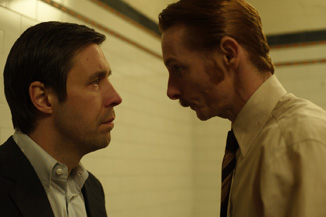Chapter Two:
Red Riding 1980
By Brett Beach
February 17, 2011
I do want to focus more specifically on 1980, rather than a comparison of all three as I am more often wont to do, for the strengths and the faults of the series are in it as much as the other two films. However, a few dry facts and observations to set the stage first. The combined running time of the films is just a few minutes past five hours. Each film does a remarkable job of evoking its time period through costume and production design rather than relying on period tunes or references to do the heavy lifting. The accents are quite thick in spots and some dialogues are impenetrable (I watched on Netflix and not DVD and so did not have the option for captions) but more often than not the melody of each scene is hummable, even if some notes get lost in translation.
The key image of the entire series, for me, is the recurring shot of a row house at the end of a block, a steeply sloping hill to the right and behind it, a path winding its way up towards a stony wall at top. That house, its inhabitants, that hill, and what lies just over the other side of the wall all play crucial parts in the first and third films. In the first film, cinematographer Rob Hardy often shoots the dwelling so that it barely takes up a fifth of the screen on the left. It always seems visually on the verge of being cut off or even run out of frame by the adjacent hill. On some psychic level, I find it quite distressing.
In the 1980 installment, a stalled investigation into the disappearance of numerous young girls results in an outside policeman, Peter Hunter, being brought in and given a fair amount of free reign to create a task force to reexamine each of the cold cases and look for connections that may have been missed or evidence that was overlooked. He is an honest cop and moral on the job — both qualities in short supply in the Yorkshire police ranks as the film presents it — but troubled at home by a marriage strained by a wife whose constant worrying for his safety leaves him stressed and her prone to miscarriages. He is ultimately brought down by his willingness to step on toes and a weakness for a fellow cop with whom he once had a fling and for whom he still harbors feelings.
Paddy Considine, the father from In America and the short-lived reporter in The Bourne Ultimatum, is Hunter, and I think he gives one of the best performances in the trilogy. To sum up his physical appearance succinctly, he is like Stephen Rea but with the latter’s hangdog glumness and wryness switched out for a still youthful, possibly naïve hopefulness. Hunter once investigated a peculiar nightclub shootout in the area (which takes place at the climax of the 1974 installment) but had to cut short his investigation for personal reasons. He views the situation entrusted with him now as a chance to make amends for that. Unfortunately, he fails to grasp the enormity of the corruption of those both aiding and attempting to derail his investigation until it is far too late. His final scene plays like a police station flip on Joe Pesci’s “Oh fuc—“ moment in Goodfellas. Those two seconds accorded to you to consider how badly you misread the situation. Two seconds after which said misreading will fail to matter.
Continued:
1
2
3
4

![]() Tweet
Tweet
![]() Print this column
Print this column



